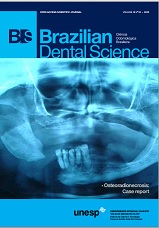What is the best protocol for bonding resin-modified glass ionomer cement to composite resin?
DOI:
https://doi.org/10.14295/bds.2015.v18i2.1077Resumo
Objective: The objective of this study was to evaluate the bond strength of resin-modified glass ionomer cement (RMGIC) to composite resin considering the use of conventional and self-etching adhesive systems. Material and Methods: 60 RMGIC blocks (Riva, SDI) measuring 4 x 4 x 4 mm. were constructed. On the blocks, the application of different protocols of adhesive systems (n = 10) was carried out: Group 1 (Control) - without application of adhesive agent; Group 2 - 37% phosphoric acid + conventional adhesive agent Single Bond 2; Group 3 - conventional adhesive agent Single Bond 2; Group 4 – conventional adhesive agent Scotch Bond Multi-Purpose; Group 5 - self-etching adhesive Clearfil SE Bond; Group 6: self-etching adhesive Optibond Allin-One. Next, resin composite blocks measuring 4 x 4 x 4 mm were constructed (Venus, Heraeus Kulzer). The specimens were cut to obtain sticks which were submitted to microtensile bond strength test in a universal testing machine. The data were submitted to ANOVA and Tukey test (5%). Results: ANOVA showed a value of p < 0.05, which indicated significant differences between the groups (in Mpa): Group 2 - 32.83; Group 5 - 31.2; Group 3 - 25,15b; Group 6 - 22.92; Group 4 - 22.15; Group 1 - 13.84. The analysis of fracture mode demonstrated that there was a predominance of adhesive and mixed fractures for all groups. Conclusion: The protocols of acid etching + conventional adhesive system Single Bond 2 (Group 2) or self-etching adhesive system Clearfil SE Bond (Group 5) increased the bond strength of RMGIC to the composite resin. The presence of an adhesive layer between the two materials tended to improve the bonding of RMGIC to composite resin.
Downloads
Downloads
Publicado
Como Citar
Edição
Seção
Licença
TRANSFERÊNCIA DE DIREITOS AUTORAIS E DECLARAÇÃO DE RESPONSABILIDADE
Toda a propriedade de direitos autorais do artigo "____________________________________________________________________" é transferido do autor(es) para a CIÊNCIA ODONTOLÓGICA BRASILEIRA, no caso do trabalho ser publicado. O artigo não foi publicado em outro lugar e não foi submetido simultaneamente para publicação em outra revista.
Vimos por meio deste, atestar que trabalho é original e não apresenta dados manipulados, fraude ou plágio. Fizemos contribuição científica significativa para o estudo e estamos cientes dos dados apresentados e de acordo com a versão final do artigo. Assumimos total responsabilidade pelos aspectos éticos do estudo.
Este texto deve ser impresso e assinado por todos os autores. A versão digitalizada deverá ser apresentada como arquivo suplementar durante o processo de submissão.




























